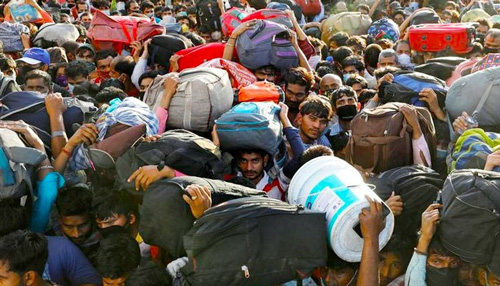New Delhi
Indian Prime Minister Narinder Modi’s coronavirus plan backfired as it led the poor and the migrant workers to extreme poverty, wrote Hartosh Singh Bal, the political editor of The Caravan magazine in New Delhi, in an opinion piece that appeared in The New York Times on Wednesday.
The premier imposed the world’s biggest lockdown on March 25 without proper administrative planning and follow up.
According to Bal, “Hundreds of thousands of migrant workers were left without wages after the lockdown imposed with a four-hour notice closed factories and businesses. They couldn’t pay rent; they didn’t have enough to eat. They looked toward their villages, where they could find shelter and food by relying on extended family.”
PM Modi, according to the author, announced steps to impose a lockdown across the country with little or no administrative follow up. “With the public transport suspended, the workers set out on foot, walking hundreds of miles in temperatures as high as 100 degrees Fahrenheit. In May alone more than 150 migrant workers walking back home have been killed in road or train accidents.”
While the number of fatalities in India remains low — Over 4,000 deaths and more than 151,000 infections — the country’s medical infrastructure is bearing the brunt of the lockdown as several hospitals are running at full capacity.
73% of all the COVID-19 related deaths have taken place among patients of 65 years old or older, according to data from New York City, while only 5% of the Indian population falls in this age group, as opposed to 16% of the American population — giving India an upper hand due to its demographics.
“The most significant question now is whether the government has made adequate use of the time the long lockdown bought it to prepare for the problems that lie ahead. The number of cases is rising steadily and is expected to continue to rise as the lockdown is now being lifted in the face of increasing pressure on the economy,” read the opinion piece.
It mentioned that the country’s minister for health said that India had 31,250 intensive-care unit beds and that “4.8%” of coronavirus patients required the ICU beds.
“It suggests that coronavirus cases would have to increase fivefold for India to run out of beds to treat patients requiring critical care. But aggregate data does not take into account the fact that the infections are not evenly spread across the country,” stated Bal.
The country’s majority chunk of cases, 60%, have been reported from five cities, Mumbai, Delhi, Ahmedabad, Chennai, and Pune.
Among these five, healthcare facilities in Mumbai — which account for 20% of the cases — and Pune, are running out of hospital beds and they cannot cope with the rising cases.
The situation in Modi’s home state, Gujrat, is also bleak as public hospitals were running on full capacity and private hospitals were exploiting people.
The Gujarat High Court intervened and remarked that “an ordinary man will never be able to afford to avail adequate treatment from a private hospital,” given the fee being charged.
“The high court pointed out that the most glaring problem with Modi’s badly planned lockdown was the crisis of hunger it had unleashed among India’s migrant workers and the poor. ‘They are not worried about the virus,’ the court remarked. ‘They are worried about food,’” wrote the author.
The Modi administration has to ramp up efforts to stabilise the country’s condition as it had enough breathing room to do so. “He will have to move beyond their focus on managing public perception.”
The COVID-19 is spreading fast locally among the urban clusters of the poor who cannot afford social distancing. It is the country’s poor who have faced and will face adversities due to the coronavirus lockdown and its implications on the economy.—AFP









